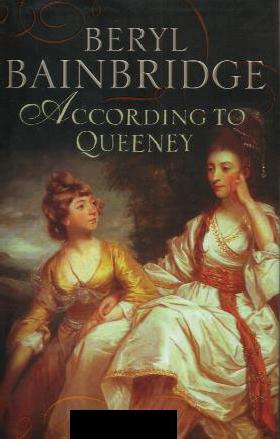
Beryl Bainbridge
For the first time in the history of the Booker Prize the initial longlist of novels has been released.
The total number of books submitted for this year's prize was 102. Books from the call-in list and additional books requested by the judges totalled 17, bringing the total number of entries to 119. From this, the judges have selected a longlist of 24 books, as follows (excluding those on the shortlist):
I for one would be really interested to find out what the other 95 novels were. Can't see it happening anytime soon, though.

|
According to Queeney Beryl Bainbridge |
Dustjacket synopsis:
"In 1764, the great Samual Johnson, irascible genius, unparalleled wit and the toast of all society, is plagued by ill
health and has become jaded with his bickering dependants. Suffering from a bout of melancholy, he accepts an
introduction to the table of Henry thrale, a wealthy Southwark brewer, and his vivacious wife Hester. Thus begins an
extraordinary relationship that is to last twenty years - and allows us into a world unknown to James Boswell.
"As Johnson settles into the generous niche established for him in the Thrales' crowded and hectic household, he comes to increasingly rely upon Hester Thrale, and their intimate friendship develops into something darker and more ambiguous. The family is drawn into the raucous, chaotic caravan of Johnson's friends and admirers: Garrick and Goldsmith, Fanny Burney and Joshua Reynolds, sycophants, scholars and drunkards, and it is left to Hester's neglected oldest daughter, named after her mother but known as Queeney, prodigiously clever, spirited and mocking, to provide her own sharp commentary on the destruction that ensues.
"Against the brilliant background of Georgian London, According to Queeney candidly and comically tells a story of unrequited love, passion, rejection and possession, revealing the sexual tensions that lie beneath the ordered surface of everyday life."
First Paragraph:
On the morning of December 15th, 1784, a day of bleak skies heralding snow, a box-cart rattled into Bolt Court and drew up outside Number 8. Three men entered the house and presently emerged carrying a roll of threadbare carpet as though it were a battering ram.
Mrs Desmoulins, shawl tight against her, remained on the steps of the house and forced tears from her eyes. Though she felt grief, she was too old, too used to death, to weep without an effort. She stood alone, save for a black and white cat busy washing itself. A number of neighbours came out and waited with bowed heads until the cart had gone from sight. From the open window of Number 6 could be beard the jangling of a spinet. It was not known whether Mr Kranach, a man who summer and winter wore a coat lined with the fur of a white wolf, was serenading the departed or merely about his daily practice.
The conveyance turning into Fleet Street, a gaggle of urchins ran in pursuit and leapt for the tail-board, at which the driver flicked backwards with his whip. Francis Barber, walking behind, accompanied his master as far as the church of St Clement Danes in the Strand; then, the bitter cold of the early hour getting to his living bones, he ducked away and sought refuge in a tavern.
Arriving in Windmill Street, the cart trundled into the yard of William Hunter's School of Anatomy. The carpet was carried to the top floor and laid on a dissecting table. A fire roared in the grate and the air was filled with an aroma of herbs, that of mint being the most pervasive. In the corner of the cosy room, a dog, half-flayed, hung from a hook in the ceiling; above, the grey heavens nudged the skylight.
From the Little Brown hardback edition, 2001.
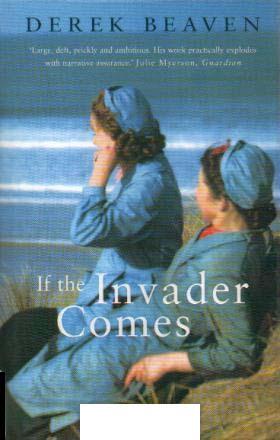
|
If the Invader Comes Derek Beaven |
Dustjacket synopsis:
"Clarice Pike and Vic Warren are from comletely different backgrounds. An impossible affair has already driven them
thousands of miles apart. But in 1939, as the world erupts with a terrible violence, their feelings conspire to draw the
lovers back together."
Quotes:
"Large, deft, prickly and ambitious. His work practically explodes with narrative assurance." - Julie Myerson,
Guardian
"Vic and Clarice are not asking for much, simply to be together. Yet with the intensifying horror around them,
plus the burden of their own secrets and deceits, that simple ambition tests them both in this powerful, sharply conceived
novel." - Dominic Bradbury, The Times
"Beaven has a gift for creating insistently human individuals who prove to be illuminating under pressure...a fine
engagement with the largest and smallest details of what it is to be English." - Lavinia Greenlaw, TLS
"He gives us all the uncertainty, liveliness, rumours and unheroic struggles of the present...as clear as a Vermeer
mirror." - David Robertson, Scotsman
"A remarkable feat of imagination." - Francis King, Literary Review
First Paragraph:
It opens in paradise, with my great-uncle. He was woken by a thud from the ceiling directly over his head, followed by a flurry of squeals, as the little cobra that seemed to have got into the roof caught another rat. In the darkness of the bedroom, Dr Wulfstan Pike lay under his mosquito net and listened to the drench hitting the bungalow thatch and the cascade of rivulets from the eaves on to the garden outside his window. He could distinguish, too, the pelt of huge globes of water into the puddles in the compound. The steamy rot smell from the old carpet mingled with the flavour of his own sweat.
He felt under the sheet for the woman lying at his side. Selma stirred in her sleep and turned over towards him; his palm traced the child-strectched skin of her belly to rest on the prominence of her hip. He smoothed the curve to her waist, and, as he bent his head near her hair on the pillow, he caught both the savour of the food she prepared, and the deeper note of her body's secretions. The spicy confluence in his nostrils was so tender that he woke her with his kisses.
From the Fourth Estate paperback edition, 2002.
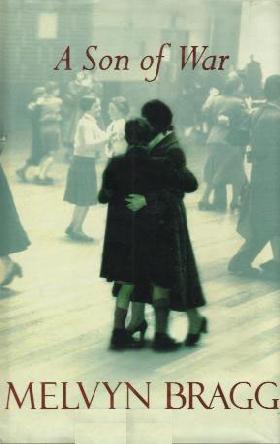
|
A Son of War Melvyn Bragg |
Dustjacket synopsis:
"The upheavals of the Second World War reverberated in the peace that followed, and many found a return to the old life
more difficult than they had anticipated. Like Sam Richardson, who was determined to break free of the constraints of
his background and leave Cumbria for the promised land of Australia. Yet now, a few months on, he has settled for a job
in Wigton's paper factory, and believes he has put both his aspirations and his memories of fighting in Burma behind
him. His wife, Ellen, begins to know better, realising how close to the brink their marriage had come. Between them
their young son Joe strives to fulfil their conflicting expectations for him, as he meets the hurdles of childhood and
adolescence and confronts his own demons.
"A Son of War portrays a family forever altered by an experience subsequent generations can scarcely imagine, yet whose individual hopes, compromises and quiet triumphs form the fabric of everydav, universal life. Crafted with potent understatement and acute insight into the twists and turns of the heart, this is a formidable successor to Melvyn Bragg's widely praised and award-winning novel, The Soldier's Return."
First Paragraph:
'You can hit as hard as you like and it won't hurt.' Sam whispered the rehearsal as he laid out the big boxing gloves like a bouquet on the table. The words would be addressed to his son but they were aimed at his wife.
The training gloves, blood red, almost new, glistening in the white gas-light of late winter afternoon, were nuzzled close, the knuckle to puffy knuckle, as if waiting for the bell.
Sam stood back to admire them. Nothing in the room compared. Even the thickly berried holly, which Ellen had refused to take down on Twelfth Night with the other decorations, was eclipsed. The berries might be 'red as any blood' but the boxing gloves were redder and bloodier and spoke for a power beyond the holly, as Sam knew. He stoked the fire and settled the kettle on it, took the News Chronicle and lit a dog end. But he could not keep his eyes off the snuggling of the large glistening gloves, almost alive as the faintly hissing light played over them; reminded him of new pups. He hummed as he waited - 'Give me five minutes more'. He wanted to extend the time for himself alone with this magnificent present. 'Only five minutes more in your arms'. Blackie air-lifted into his lap so lightly it was almost an embrace, and when Sam stroked her under the chin she purred to match the quiet murmur of the kettle. Sounds full of peace: he felt his mind untense in this quietness that screened no threats.
From the Sceptre hardback edition, 2001.
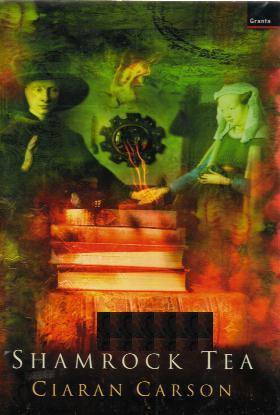
|
Shamrock Tea Ciaran Carson |
Dustjacket synopsis:
"Shamrock Tea is Ciaran Carson's most ambitious book to date. Like Fishing for Amber, it delights in stories
and their meandering connections with an infinity of other stories. The Arnolfini Portrait is at the centre of the
book, the great van Eyck painting of a merchant and his wife in the city of Bruges. Around the painting swirls a galaxy
of esoteric and entertaining knowledge of saints' days, herbal cures, animal symbolism, miracles and transformations.
"Shamrock Tea, the magical substance that allows people to experience the world with visionary clarity, can only be found by passing through the van Eyck painting into another world. The characters who bear this knowledge include a young boy called Carson, his uncle Celestine, his cousin Berenice, Ludwig Wittgenstein, Father Brown, and young Maeterlinck, the nephew of Maurice Maeterlinck, an art-dealer in the Flemish city of Ghent. Everthing connects with everything else: one of the book's presiding geniuses is Arthur Conan Doyle, who believed that you could read the world in a drop of water. Shamrock Tea is a homage to this idea, to an almost medieval sense of the unity of the world - what in other words we call magic."
First Paragraph:
Perhaps I will return one day to the world I first entered. For now, I wish to record something of it, if only to remind myself of what I am.
The first things I remember are the colours of my bedroom wallpaper, and their chalky taste under my fingernails. It would, of course, be years before I learned what the shades were called, which leads me to my first paint-box. Hooker's Green, Vermilion, Prussian Blue, Burnt Sienna: I knew stories must lie behind those names, and I resolved to discover them some day.
As I learned to speak, I understood that green was the colour of jealousy. But I did not know yet that Napoleon, on the isle of St Helena, was supposed to have died from breathing the fumes of his bedroom wallpaper, which was liberally tinted with the arsenic-laced pigment known as Emerald, or Paris Green; nor did I know that a green moon shone in the sky for weeks after Krakatoa disintegrated on 28 August 1883, the feast day of St Monica, mother of St Augustine.
From the Granta Books hardback edition, 2001.

|
The Element of Water Stevie Davies |
Dustjacket synopsis:
"As the Third Reich lies in ruins, Hitler's successor Admiral Dönitz and his abortive government retreat north to Lake
Plön. In the midst of the chaos Michael Quantz, German ex-intelligence officer, must find his wife and child and etablish
a new identity under the Allied regime. Thirteen years later, memories of the war are rekindled when the daughter of Paul
Dahl, his childhood friend and SS zealot, arrives on the shores of Lake Plön. Submerged beneath the still dark waters of
the lake lie the remnants of war - uniforms, medals and weapons discarded by the retreating German army. What secrets will
the next generation uncover as they delve into their fathers' pasts? and can they move beyond the racial hatred spawned
by the war?
"The Element of Water is a powerful and compassionate study of conflicting emotions in post-war Germany and the waning British Empire. But it is also a tender love story, raising universal questions about the nature of memory, guilt and survival."
Quotes:
"Stevie Davies holds you in a narrative spell" - Guardian
First Paragraph:
Lake Plön, April-May 1945
Michael Quantz transiently haunted the lakeside, pausing, screwing up his eyes against the sheen of grey light. Waves spilt at his feet, drizzle fell with calm steadiness, and he found himself at a standstill.
One rarely indulged the luxury of thought nowadays. All did without sleep, catnapping in odd half-hours or getting caught short, jerking to consciousness with a mouthful of sourness, a staleness of cigarette smoke, lungs coated in a raw residue of tar, sweat caking the body within its uniform. jolted awake, there was surprise at having been taken by the permanently denied sleep, which stalked like a predatory lover to whom no upright man should surrender.
All looked pasty, cadaverous, defective, under the unforgiving light. The businesslike efficiency of men working at top speed took on a blue blur through the cigarette smokescreen; naval uniforms seemed dusted with powder, like bloom on fruit, and everyone looked off-colour. Admiral Dbnitz's unnervingly competent secretaries kept up a martial tempo of typing, brisk, fresh-looking. Their fingers marched on the keys, processing messages, each one more urgent, more abysmally meaningless than the last, intermittently glancing up at the clock above the admiral's door.
What time is it? What time? How much time do we have?
Time pressed and something must be done: some last-ditch push to ward off total defeat, although it was numbly known that defeat was already total.
From the Women's Press paperback edition, 2001.

|
The Pickup Nadine Gordimer |
Dustjacket synopsis:
"Who picked up whom?
"Is the pickup the illegal immigrant desperate to evade deportation to his impoverished desert country?
"Or is the pickup the powerful businessman's daughter trying to escape a privileged background she despises?
"When Julie Summers' car breaks down in a sleazy street, at a garage a young Arab emerges from beneath the chassis of a vehicle to aid her. The consequences are unpredictable and intense, as each person's notions of the other are overturned.
"What are the solutions life demands for extraordinary circumstances? A novel of swift power and concision, The Pickup is set in the social mix of the new South Africa and an arab village in the desert. It is the story of the rites of passage that are emigration/immigration, anywhere in the world, where love can survive only if stripped of all certainties outside itself."
Quotes:
"This is fiction as it should be, serious in intent and execution yet gripping and deeply satisfying" - Margaret Forster
First Paragraph:
Clustered predators round a kill. It's a small car with a young woman inside it. The battery has failed and taxis, cars, minibuses, vans, motorcycles butt and challenge one another, reproach and curse her, a traffic mob mounting its own confusion. Get going. Stupid bloody woman. Idikazana lomlungu, le! She throws up hands, palms open, in surrender. They continue to jostle and blare their impatience. She gets out of her car and faces them. One of the unemployed black men who beg by waving vehicles into parking bays sidles his way deftly through fenders, signals with his head - Oka-ay, Oka-ay go inside, go! - and mimes control of the steering wheel. Another like him appears, and they push her and her car into a loading bay. The street hustles on. They stand, looking rousingly beyond her while she fumbles for her purse. An expert's quick glance at what she has put in his hand assures the street boss that it is more than adequate. She doesn't know how to thank them enough, etc. He hitches his body to get the money stowed in trousers cut to fit somebody else and smiles with his attention on the lookout for the next vehicle seeking a place to park. A woman wearing a towel as a shawl, enthroned on a fruit-box before her stock of hair combs, razor blades, puinice stones, woollen caps and headache powders, yells out to him what must be a teasing remark in a language the young woman doesn't understand.
There. You've seen. I've seen. The gesture. A woman in a traffic jam among those that are everyday in the city, any, city. You won't remember it, you won't know who she is.
But I know because from the sight of her I'll find out - as a story - what was going to happen as the consequence of that commonplace embarrassment on the streets; where it was heading her for, and what. Her hands thrown up, open.
From the Bloomsbury paperback edition, 2001.
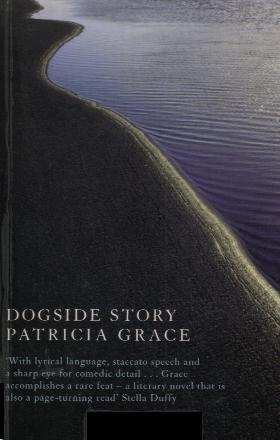
|
Dogside Story Patricia Grace |
Dustjacket synopsis:
"Twenty-four-year-old Te Rua holds a secret, 'one to die with'. But if he is to rescue his daughter Kiri from the
neglectful care of his aunts then the truth will have to be told. As the custody case approaches, and tourists arrive on
the Dogside coast for the first sunrise of the new millenium, not only will his confession shame his family but it will
reverberate throughout the whole community.
"By one of New Zealand's finest writers, this rich, dramatic novel about what it is that builds the life-preserving strength of family presents a powerful picture of Maori in modern times."
Quotes:
"With lyrical language, staccato speech and a sharp eye for comedic detail...Grace accomplishes a rare geat - a literary
novel that is also a page-turning read" - Stella Duffy
First Paragraph:
This first part of the story is about two sisters, Ngarua and Maraenohonoho, who quarrelled over a canoe.
The sisters lived on the coast of the north side of a tidal river that came down from far back in the ranges and mouthed out into a wide bay. Far beyond the bay was where the morning sun tipped up out of the sea and flipped back across the sky like a slow, many-coloured fish, travelling the high arc until it dropped and splashed down again beyond the mountains. This northern curve of the bay was bordered by rock and steep white cliffs. In the clearings, here and there between the inlet and the cliffs, people had built their ancestral house, their sleeping houses and cooking shelters, and had made their gardens.
On the other side of the inlet, bordering the south end of the bay, were low cliffs of yellow rock centred by a blowhole which at low tide stood dry, enabling a way through to a sheltered cove which was a favoured fishing place. At this time no one lived on the south side.
From the Women's Press paperback edition, 2001.
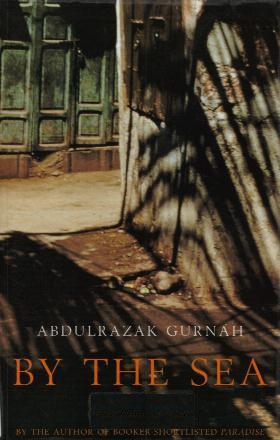
|
By the Sea Abdulrahzak Gurnah |
Dustjacket synopsis:
"'I live in a small town by the sea, as I have all my life, though for most of it it was by a warm green ocean a long
way from here.'
"In the later afternoon of 23rd November Saleh Omar arrives at Gatwick Airport with a small bag in which there lies a mahogany box containing incense - and little else. He used to be a furniture-shop owner, house owener, husband and father. Now he is an asylum seeker from paradise, claiming silence as his only protection.
"Meanwhile, Latif Mahmud, poet and professor, voluntary refugee, lives quietly, alone in his Lndon flat, bitter about the country and family he has never revisited.
"The paradise these men have left is Zanzibar, an island in the Indian Ocean swept by the winds of the Musim, bringing traders with their perfumes and spices and a unique mix of cultures.
"When Saleh and Latif meet in a small English seaside town, there begins the unravelling of a story begun long ago - a story of seduction and deception, the the haphazard displacement of people, a story of love and betrayal and above all of possession. And as the story unwinds, we see a country exploding into post-colonial independence, spinning in its attempt to find stability while its peope are caught in the maelstom of their times.
"Abdulrazak Gurnah's sixth novel is a stunning and elegaic look at a world where imperialism has opened up boundaries only to close off borders. Passionate and profound, it reveals an author at the height of his powers."
First Paragraph:
She said she'll call later, and sometimes when she says that she does. Rachel. She sent me a card because I don't have a telephone in the flat, I refuse to have one. In the card she said that I should call her if her coming was a problem, but I haven't. I have no urge to do so. It's late now, so I don't suppose she'll be coming after all, not today.
Though, in the card she did say today after six. Maybe it was only one of those gestures that was complete when it was made, to say that she had thought of me, in the sure expectation that I would take comfort from that, which I do. It doesn't matter, just that I don't want her turning up in the deep hours of the night, shattering its pregnant silences with a racket of explanations and regrets, and blurting out plans to take away more of the remaining hours of darkness.
I marvel how the hours of darkness have come to be so precious to me, how night silences have turned out so full of mumbles and whispers when before they had been so terrifyingly still, so tense with the uncanny noiselessness that hovered above words. As if coming to live here has shut one narrow door and opened another into a widening concourse. In the darkness I lose a sense of space, and in this nowhere I feel myself more solidly, and hear the play of voices more clearly, as if they were happening for the first time. Sometimes I hear music in the distance, played in the open and coming to me as a muted whisper. I long for night each and day, even though I dread the darkness and its limitless chambers and shifting shadows. Sometimes I think it is my fate to live in the wreckage and confusion of crumbling houses.
From the Bloomsbury paperback edition, 2001.
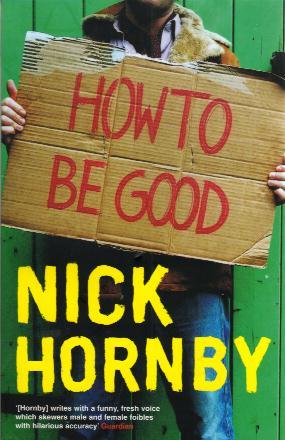
|
How to be Good Nick Hornby |
Dustjacket synopsis:
"According to her own complex moral calculations, Katie Carr has earned her affair. She's a doctor, after all, and doctors are decent people, and on top of that her husband David is the self-styled Angriest Man in Holloway. When David suddenly becomes good, however - properly, maddeningly, give-away-all-his-money good - Katie's sums no longer add up, and she is forced to ask herself some very hard questions...
"Nick Hornby's brilliant new novel offers a painfully funny account of modern marriage and parenthood, and asks that most difficult of questions: what does it mean to be good?"
Quotes:
"[Hornby] writes with a funny, fresh voice which skewers male and female foibles with hilarious accuracy" -
Guardian
"He should write for England" - Observer
"Hornby is a writer who dares to be witty, intelligent and emotionally generous all at once" - The New York Times
First Paragraph:
I am in a car park in Leeds when I tell my husband I don't want to be married to him any more. David isn't even in the car park with me. He's at home, looking after the kids, and I have only called to remind him that he should write a note for Molly's class teacher. The other bit just sort of...slips out. This is a mistake, obviously. Even though I am, apparently, and to my immense surprise, the kind of person who tells her husband that she doesn't want to be married to him any more, I really didn't think that I was the kind of person to say so in a car park, on a mobile phone. That particular self-assessment will now have to be revised, clearly. I can describe myself as the kind of person who doesn't forget names, for example, because I have remembered names thousands of times and forgotten them only once or twice. But for the majority of people, marriage-ending conversations happen only once, it at all. If you choose to conduct yours on a mobile phone, in a Leeds car park, they you cannot really claim that is it unrepresentative, in the same way that Lee Harvey Oswald couldn't really claim that shooting presidents wasn't like him at all. Sometimes we have to be judged by our one-offs.
From the Viking paperback edition, 2001.

|
Wolfy and the Strudelbakers Zvi Jagendorf |
Dustjacket synopsis:
"Set in wartime and post-war England Wolfy and Strudelbakers is a comic take on the disaster zone of displacement
and exile. Wolfy lives with the 'strudelbakers' - his super-critical aunt and melancholy uncle - in the surrealistic
world of refugees granted shelter from persecution. He is an expert at living in two cultures - the chaotic, dark world
of uprooted people desparately hanging on to their Jewish religion - and the vitality, variety and temptation he finds in
London streets.
"Wolfy observes it all with a sharp eye; the bafflement of his English neighbours at the odd, secretive nature of his Jewish family and their comical habits as they reluctantly learn to stop being 'aliens' and discover England through blitz, evacuation, menial work, school reports, team sports and Christmas. ForWOlfy everything is new and exciting. He is a success as a budding Englishman. He lives near Arsenal Football Club, practises ballroom dancing with the help of the BBC and, of course, he is getting ready for girls.
"Born in Vienna, Zvi Jagendorf now lives in Israel. He teaches English and Theatre Studies at Hebrew Univeristy, Jerusalem. His short stories have been widely published and he contributes regular reviews and articles to a broad range of magazines both in Israel and abroad."
Quotes:
"Rightly included among the Naipauls and the McEwans on the Booker Long List; it would be a small travesty if Wolfy did
not inveigle his way at least into the final six." - The Observer
"A most impressive novel full of narrative power and unforgettable description." - Jewish Chronicle
"Astonishing finesse." - Guardian
"Beautifully evocative, combining pathos with humour." - City Life
"A quiet gem...good humour and high quality writing." - The Daily Telegraph
"The delight is in the comic detail, even when the matter is serious." - The Times
First Paragraph:
He was a deadman travelling in a tram through Vienna on a Saturday evening in 1937 with empty pockets. He wore a dark, old-fashioned suit and a white shirt buttoned with no tie. A handkerchief was stuffed into his jacket sleeve at the wrist. On his head sat a broad-brimmed black hat and a neat white beard lay over his throat and chest like a napkin. His black shoes were poished and white sicks peeped through the space between shoe and trousers. His skin was white, almost transparent, his body was frail and delicate, so delicate that he took up less than half his seat in the front by the window. From behind he seemed a painted cardboard doll, stiff and upright, unmoving in the moving vehicle, etched out sharply in two colours against the reflections, gleams and changing lights of the passing scene. In his pockets he had nothing. There was no money or wallet and no keys. He had no pen or pencil or scap of paper with notes about what to do and what to buy. No letter in any language or envelope with any address was in any of his pockets, not even a paper clip or a sweet or a half-smoked cigarette. He carried no permits or identity card or proof of residence in any place on this earth. In his right hand he held a ticket bought with the exact change and that was all he had except for a thin gold wedding ring on the middle finger of that same hand.
From the Dewi Lewis paperback edition, 2001.
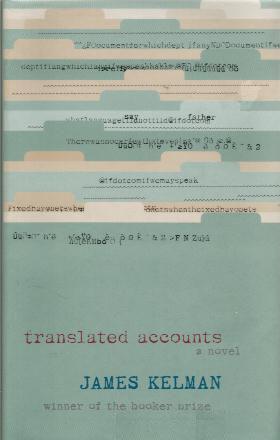
|
Translated Accounts James Kelman |
Dustjacket synopsis:
"Since the publication of How Late It was, How Late James Kelman has been working on Translated Accounts.
The new novel is set in an unnamed territory or country that appears to be under military rule. It is narrated in the first
person, but the narrators remain anonymous, as do most of the other characters. The language used is an atypical English
form, but akin to the basic translation that might appear within a department of an overseas 'foreign office'. Perhaps
someone transcribed first-hand accounts of certain incidents, events and states of mind, as narrated by participants in
the struggle and then passed on the transcription for translation; or perhaps the accounts were simply translated first hand
into English and edited later. In either case the results were dispatched to a more senior civil servant who later handed
them over to an appropriate state agency.
"Formally groundbreaking and verbally dazzling, Translated Accounts is a work of compelling importance from a modern master."
First Paragraph:
There were bodies strewn throughout the building. I had to reach other rooms and it was so very difficult to walk, having to step over them, and it was so very dark the shapes hardly visible, whether any of these were familiar I could not say, could not stop, but had to reach this one individual,
This acquaintance, this man who was closer to enemy than friend, I was to save him. But perhaps he preferred not so to be saved, that 1 should leave him to die. I could not help him in that. I would do as so determined, only that. I was representative.
I considered the time, what time? When was it? I now saw him and my irrunediate thought was, No, he never was my friend. Did they say that he was? They lied, as he also, he was a liar, this man. I knew him as a liar and it came to me this was a progression. We progress. I also would progress. A comfort cane from this. I again was aware of the bodies but as in a dream, or dream-like, my own state. One by my feet, a woman. She had been dead for many years but her face and kind were familiar. If I had known her, her family, 1 thought I had done so, thus her sister now into my thoughts, what of her, who was to become my lover. How could it be? Niece, granddaughter. She too lived by the bridge. It was far to the harbour, northeast of there, and a river also there, families lived by it. It was an encampment, when in transit, they made a dwelling of that place, evil place, some said so. I knew dripping water, sewage, the dampness into out bones, and cold, of course cold.
From the Secker & Warburg hardback edition, 2001.
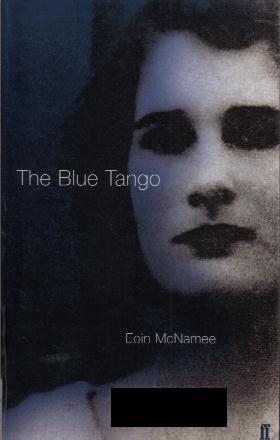
|
The Blue Tango Eoin McNamee |
Dustjacket synopsis:
"'At 2.20 in the morning of 13 November 1952, the body of nineteen-year-old Patricia Curran was carried into the
surgery belonging to the family doctor. Following a preliminary examination Dr Kenneth Wilson concluded that
she had been the victim of an accidental shooting because of the pattern of the wounds. In fact a subsequent post-mortem
revealed that she had been stabbed thirty-seven times.'
"The Curran family were tainted by scandal from the beginning - Judge Lance Curran, ambitious and driven, weighed down by gambling debt; the ascetic Desmond, lost in religious zealotry - and there were rumours of savage disagreements between Patricia and her mother. But most of the doubt concerned Patricia herself. Was she a spirited and confident proto-feminist, or an upper-class demi-mondaine, demanding and promiscuous? In a storm of publicity, rumour and counter-rumour, Scotland Yard dispatch Chief Inspector John Capstick, who uncovers a complex web of deceit. Determined to secure a conviction, Capstick's focus falls on a peripheral figure, a young army conscript, Iain Hay Gordon, who finds himself fighting for his life in the shadow of the gallows.
"Eoin McNamee's wonderful new novel, which is based on one of the greatest miscarriages of justice in recent history, is at once a gripping thriller and a danse macabre through a shadowy world of corruption and sexual intrigue. This darkly lyric narrative of white mischief in post-war Ireland, of false accusation and savage murder, is presided over by the haunted, tragic figure of Patricia Curran."
First Paragraph:
At 2.20 in the morning of 13 November 1952, the body of nineteen-year-old Patricia Curran was carried into the surgery belonging to the family doctor. Following a preliminary examination Dr Kenneth Wilson concluded that she had been the victim of an accidental shooting because of the pattern of the wounds. In fact a subsequent post-mortem revealed that she had been stabbed thirty-seven times. While waiting for RUC detectives to travel to his surgery in the village of Whiteabbey, five miles from Belfast, Dr Wilson estimated that Patricia Curran had been dead for not less than four hours.
Two men had carried Patricia's body into the surgery: her brother, Desmond Curran, and the family solicitor, a man called Malcolm Davidson. Malcolm Davidson's wife stayed in the car. Desmond led the cortčge with dismal authority, like a man who supposed he held rightful office to the carriage of corpses by night.
From the Faber paperback edition, 2001.
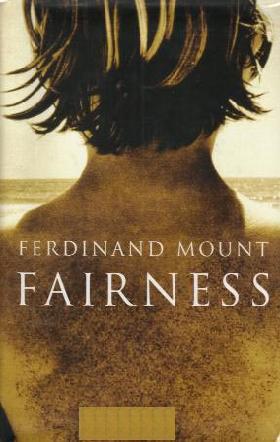
|
Fairness Ferdinand Mount |
Dustjacket synopsis:
"'There she is, coming out of the mist towards me, quite thick mist sometimes, and she's not always calm, far from it,
but somehow she's still ahead, further into life, and her hair the same milky gold.'
"Fairness is about Helen, the tiny, blonde, serious girl whoe the narrator meets when they are both looking after children during a summer vacation in Normandy. Her adventures in search of a morally satisfying life lead her into situations that are neither satisfying nor moral, from the mining boom in Central Africa to the child abuse scandals of the late 1980s.
"This is the latest and most amitious novel in Ferdinand Mount's Chronicle of Modern Twilight series, and makes up the autobiogrpahy of Aldous (Gus) Cotton, the civil servant with breathing problems and sexual learning difficulties. It is also an erratic history of England in the second half of the twentieth century.
"Some of the characters from much acclaimed earlier novels in the series bob up again, such as Dr Maintenon-Smith, the Napoleon of Asthma, and Gerald Moonman, the Lytton Strachey lookalike abd editor of Frag magazine. But this is Helen's story and few of those who tangle with her are ever quite the same afterwards. Caustic, innocent and irresistible, she is a female Candide for our time."
First Paragraph:
In the morning when it was low tide the old women in black came in their black boots to dig up shellfish - winkles, cockles, I don't know what. They swung big buckets under their arms as their caber-thick legs stumped over the crumbly tarmac road through the withered sea-grass. When they came to the skimpy shelter of the bushes, they sat down to have breakfast. The ham was so thick in their baguettes I could identify it from two hundred yards and could see the steam coming off the coffee when they unscrewed the thermos. After breakfast they squatted in the bushes and hoisted their black skirts in unison, great white rumps bared to the branches of the bushes - tamarisks were they, such frail protection from the wind blowing up the Channel. Sometimes I fancied I could smell their shit, although it was impossible to open the little round window with its violet and yellow strips round a hexagon of clear glass. I fancied, too, that on a clear day I could see across to the other side and pick out the high ground where the clinic was perched in the fir trees. It was a couple of years since my father had taken me away, but I imagined the timetable would not have changed much. Just about now my fellow asthmatics would be yawning and scratching their way through their breathing exercises. There was an exquisite sense of liberation from all that as I myself yawned and scratched, although what I had stumbled into might seem like anything but a liberation.
From the Chatto & Windus hardback edition, 2001.
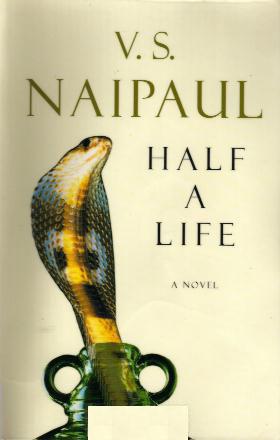
|
Half a Life V.S. Naipaul |
Dustjacket synopsis:
"In a corner of India untouched by anti-colonial agitation Willy Chandran's father stood at odds
with the world - aspiring to greatness whilst living out the dreary life marked out for him by his
ancestors. In an attempt to defy his past, he marries as good as a low-caste woman only to find himself
at the mercy of his own fury.
"From this unhappy union the utterly compelling character of Willy Chandran emerges, oddly like his father, naively eager to find something that will place him both in and apart from the world. And so he is drawn to England, to the immigrant community of post-war London, its dingy West End clubs, lonely pavements and sexual encounters, and even to the eccentric milieu of the English writer.
"But it is Willy's first experience of love that might bring him the fulfilment he so desperately seeks. His wife Aria leads him to her home, a province of Portuguese Africa, a country populated by desperate businessmen and their frustrated wives all uncertainly living out the last days of colonialism.
"Half A Life is a devastating work of exceptional sensitivity, grace and humour. In its depiction of love fulfilled and thwarted, in its vision of the half-lives quietly lived out at the centre of our restless world, V S. Naipaul's new novel brings its own unique illumination to another aspect of our shared humanity."
First Paragraph:
Willie Chandran asked his father one day, 'Why is my middle name Somerset? The boys at school have just found out, and they are mocking me.'
His father said without joy, 'You were named after a great English writer. I am sure you have seen his books about the house.'
'But I haven't read them. Did you admire him so much?'
'I am not sure. Listen, and make up your own mind.'
And this was the story Willie Chandran's father began to tell. It took a long time. The story changed as Willie grew up. Things were added, and by the time Willie left India to go to England this was the story he had heard.
The Writer (Willie Chandran's father said) came to India to get material for a novel about spirituality. This was in the 1930s. The principal of the maharaja's college brought him to me. I was doing penance for something I had done, and I was living as a mendicant in the outer courtyard of the big temple. It was a very public place, and that was why I had chosen it. My enemies among the maharaja's officials were hounding me, and I felt safer there in the temple courtyard, with the crowds coming and going, than in my office. I was in a state of nerves because of this persecution, and to calm myself I had also taken a vow of silence. This had won me a certain amount of local respect, even renown. People would come to look at me being silent and some would bring me gifts. The state authorities had to respect my vow, and my first thought when I saw the principal with the little old white fellow was that it was a plot to make me talk. This made me very obstinate. People knew that something was afoot and they stood around to watch the encounter. I knew they were on my side. I didn't say anything. The principal and the writer did all the talking. They talked about me and they looked at me while they talked, and I sat and looked through them like someone deaf and blind, and the crowd looked at all three of us.
From the Picador paperback edition, 2001.
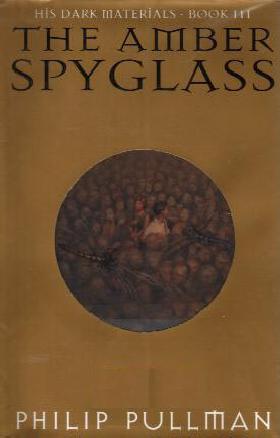
|
The Amber Spyglass Philip Pullman |
Dustjacket synopsis:
"Lyra and Will, the two ordinary children whose extraordinary adventures began in The Golden Compass and The
Subtle Knife, are in unspeakable danger. With help from Iorek Byrnison the armored bear and two tiny Gallivespian
spies, they must journey to a dank and gray-lit world where no living soul has ever gone.
"All the while, Dr. Mary Malone builds a magnificent amber spyglass. An assassin hunts her down. And Lord Asriel, with troops of shining angels, fights his mighty rebellion, a battle of strange allies - and shocking sacrifice.
"As war rages and Dust drains from the sky, the fate of the living - and the dead - finally comes to depend on two children and the simple truth of a simple story. The Amber Spyglass reveals that story, bringing Philip Pullman's His Dark Materials to an astonishing conclusion.
First Paragraph:
In a valley shaded with rhododendrons, close to the snow line, where a stream milky with meltwater splashed and where doves and linnets flew among the immense pines, lay a cave, half-hidden by the crag above and the stiff heavy leaves that clustered below.
The woods were full of sound: the stream between the rocks, the wind among the needles of the pine branches, the chitter of insects and the cries of small arboreal mammals, as well as the birdsong; and from time to time a stronger gust of wind would make one of the branches of a cedar or a fir move against another and groan like a cello.
It was a place of brilliant sunlight, never undappled. Shafts of lemon-gold brilliance lanced down to the forest floor between bars and pools of brown-green shade; and the light was never still, never constant, because drifting mist would often float among the treetops, filtering all the sunlight to a pearly sheen and brushing every pine cone with moisture that glistened when the mist lifted. Sometimes the wetness in the clouds condensed into tiny drops half mist and half rain, which floated downward rather than fell, making a soft rustling patter among the millions of needles.
From the Alfred A. Knopf hardback edition, 2000.
Note:
This novel forms the third part of the His Dark Materials trilogy, the other volumes being: Book I The Golden
Compass and Book II The Subtle Knife.
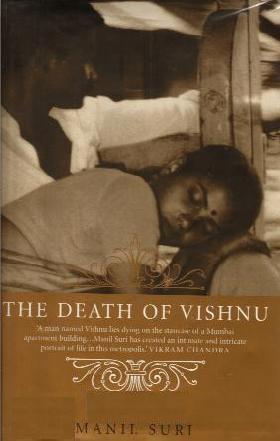
|
The Death of Vishnu Manil Suri |
Dustjacket synopsis:
"Vishnu, the odd-job man in a Mumbai apartment block, lies dying on the staircase landing. In his
fevered state he looks back on his love affair with the seductive Padmini while all around him is
played out the drama of the apartment-block dwellers: Mrs Pathak and Mrs Asrani's ferocious
bickering over their shared kitchen; Vinod Tanej's obsessively playing his dead wife's favourite
album; Mr Jalal dreaming of a path to enlightenment while his son Salim plots a film-style
elopement with the daughter of the Asranis down-stairs. Then to ignite this mix of social and
religious differences comes Mr Jaials pronouncement that Vishnu is no ordinary man...
"Blending acutely observed social detail with a dash of Bollywood sparkle, The Death of Vishnu is a breathtaking debut."
Quotes:
"Vibrantly alive, beautifully written, full of wonderfully rich and deeply human characters ... Brings to mind
... Flaubert and Flannery O'Connor." - Michael Cunningham
First Paragraph:
Not wanting to arouse Vishnu in case he hadn't died yet, Mrs. Asrani tiptoed down to the third step above the landing on which he lived, teakettle in hand. Vishnu lay sprawled on the stone, his figure aligned with the curve of the stairs. The laces of a pair of sneakers twined around the fingers of one hand; the other lay outstretched, as if trying to pull his body up the next step. During the night, Mrs. Asrani noted with distress, Vishnu had not only thrown up, but also soiled himself. She had warned her neighbor, Mrs. Pathak, not to feed Vishnu when he was so sick, but did that woman ever listen? She tried not to look at the large stain spreading through the worn material of Vishnu's khaki pants, the ones that her husband had given him last Divali. What a mess - the jamadami would have to be brought in to clean up such a mess, and it would not be free, either, someone would have to pay. Her large frame heaving against the sari in which it was swaddled, Mrs. Asrani peered at Vishnu from the safety of the third step and vowed it would not be her.
A more immediate problem had to be dealt with first - what to do about the cup of tea she brought Vishnu every morning? On the one hand, it was obvious that Vishnu did not have much need for tea right now. Even yesterday, he had barely stirred when she had filled his plastic cup, and she had felt a flutter of resentment at not having received her usual salaam in return. On the other hand, giving tea to a dying man was surely a very propitious thing to do. Since she had taken this daily task upon herself, it would be foolish to stop now, when at most a few more cups could possibly be required. Besides, who knew what sort of repercussions would rain down upon her if she failed to fulfill this daily ritual?
From the Bloomsbury hardback edition, 2001.
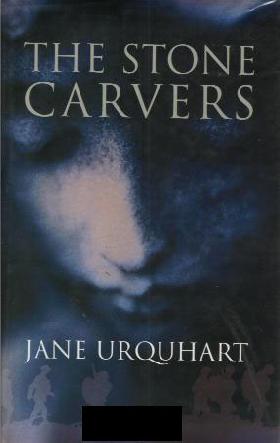
|
The Stone Carvers Jane Urquhart |
Dustjacket synopsis:
"Characters in Jane Urquhart's magnificent new novel seem to strive for the impossible. Father Archangel Gstir, a Bavarian
priest, is sent by God and King Ludwig to the wilds of Canada to set up a new parish. Recruiting Joseph Becker, an
old-world trained carver, to create a crucifix, Archangel encourages enough local pageantry, including drumming Orangemen,
to rally a congregation, and eventually to biuld a hugh stone church and install a bell.
"Several decades on, Joseph Becker is teaching his astounding carving skills to his grandhcildren. One of them, Klara, with a talent for tailoring learned from her mother and for carving learned from her grandfather, has a surfeit of what the local nuns call 'a fondness for men's work.' She also has an Irish boy, Eamon O'Sullivan, so in thrall, he can only sit speechless, watching in her kitchen, while Klara's anger, curiosity and desire do battle through his silence. But by 1914 the war has drawn many thousands to the battlefields, including Eamon, and nothing is ever the same again.
"Over a decade after the mass sacrifice, a Canadian architect called Alward determines to carve an impossibly large and ambitious memorial in finest Dalmation limestone near Vimy Ridge in France to honour the Canadian missing. It is at this monument that the unforgettable characters of Urquhart's story finally congregate with their tools and skills to carve and remember."
First Paragraph:
In June of 1934, two men stand talking in the shadow of the great unfinished monument. Behind them rises a massive marble base flanked by classically sculpted groups of figures and surmounted by an enormous stone woman who is hooded and draped in the manner of a medieval mourner. At her back, a shedlike building occupies the space between twin obelisk-shaped pylons, each with their own wooden rooms attached to it at a great height.
The taller man wears a dark overcoat and hat and carries a pole, about the size of a walking stick, that he swings out in front of him now and then as if to make a point. The other man, less formally clad in an oilskin Jacket buttoned tightly over his round belly, appears to be more involved in the conversation, looking intently at his companion and rising on his toes and opening his arms while he is speaking. All around them, all around the monument is a sea of men and mud, except in the far distance where the dark mountains of the coal fields of Lens can be seen to the northeast, and the white slabs of graveyards, some only partially sodded, can be seen to the south and to the west.
Despite the fact that the ground the men stand on is French, and the month is June, it is not a warm day; there is no sun, and the wind howls across the coal fields toward the monument in increasingly strong gusts so that the taller man is forced to place a hand on his hat. At one point both men stop talking and look up at a large wooden shed that stands on a forest of scaffolding and is secured by thick ropes to the larger of the two pylons. They listen to the strange noise these ropes make as they rub together, a noise the taller man knows to be remarkably similar to the sound of two pines scraping against each other in a wind-filled Canadian forest. Along with the wind and the sound of the ropes there is the staccato noise of several stonecutters' tools as men in overalls carve words onto the extensive stone wall. The taller man walks across broken marble and rutted mud to see how this work is going. He says a few words to one of the stone carvers, then returns to his companion.
It begins to rain.
From the Bloomsbury hardback edition, 2001.
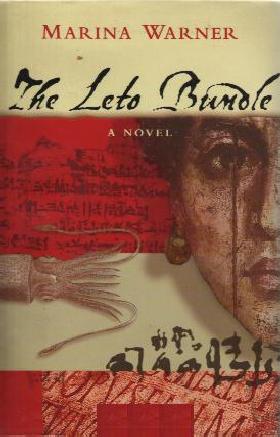
|
The Leto Bundle Marina Warner |
Dustjacket synopsis:
"Full of mystery and myth, sensual imagery, sharp observation and surprise, Marina Warner's compelling new novel unfolds
a story of civil war, dispossession and survival that sweeps the reader from a turbulent past into a troubled present.
"Room XIX of the Museum of Albion doesn't usually receive many visitors. But one day a crowd of immigrants and homeless gather and demand to see a mummy that has recently been removed. As political pressure builds, the curator unpacks the tomb and begins to explore its bizarre contents, for herself and for the passionate young man who has adopted the mummy as the figurehead of his movement. It contains a bundle of curious objects and documents: they tell of the wanderings of an unknown woman, Leto.
"As Leto moves gradually westwards across the map from her childhood home, she slips through time. On the run, in a far off era of civil strife, she gives birth to twins, shelters with wolves, survives in a desert stronghold as the lover of its commander, stows away on a ship loaded with plundered antiquities and then works as a chamber maid in a wanton city. During a long siege she manages to save her daughter, but loses her son. As the novel sweeps from mythological times and the Middle Ages, to the treasure-hunting of Victorian Europe, and into the present day, Leto reappears, with her daughter Phoebe, in different guises. Eventually, in today's Albion, Leto becomes a servant in the household of a rock singer; there, she begins to seach for her son.
"Inspired by classical romance, crusader chronciles, Victorian adventures and contemporary events, The Leto Bundle retells the story of the eternal refugee in a dramatic modern novel of huge scope and imaginative force."
First Paragraph:
In the customs depot on the airfield in Shiloh, several crates were padlocked behind chainlink fences in a single pen. Bonded goods, perishable and hazardous materials, special interest cargoes to declare, valuables and treasures of all kinds were stored there, randomly, awaiting clearance. although the containers wore precise dockets, labels of provenance and destination, and many warning notices in HAZCHEM liveries of red, black, and yellow, most kept their contents secret. Doctor Hortense Fernly could pick out the bulky, well-buttressed pine box that she was conducting; she was pleased to see that it had been placed right side up. Near it, through the bars of the small windows on either side of a special airfreight box, the eye of a racehorse could be glimpsed, and a groom was standing close up against the wire: 'There there, my beauty, there there,' he was cooing. 'Don't fret, it won't be long now.' He made soft sounds against his teeth and the mare heaved and stamped in response, but quietly, as if familiar with the wait in her constricted quarters. And in a corner of the shed, a widow keened quietly through the wire over the coffin of her husband.
Hortense Fernly was a museum curator, the deputy keeper of Classical Antiquities at the National Museum of Albion. When she was at work in the building, she kissed an electronic scanner with the special card round her neck to gain access through nuclear-proof steel doors to the vaults where the most precious objects, paintings, sculptures and documents were kept. But treasures were unpredictable these days: no longer dragons' hoards of precious stones, shooting such bright lights they lit up their hiding place, no longer verdigris'd doubloons spilling from crocks of pirates in concealed coves of palm-fringed islands. Hortensc had colleagues who extilted over a chipped badge from a fafled protest movement or the end of a roll of film in a rusty can; meanwhile the salerooms were full of luxuries and souvenirs - celebrity relics, preferably hauled from the site of a shipwreck, or the bedroom of a suicide. In her field of expertise treasures were usually broken and lustreless: potsherds, moth-casings of papyri, tatters of painted linen. She might find, in a tray of rubble, the single, crooked piece of elbow that solved a shattered marble figure's pose, or the fragment with a speech from one of a great tragedian's lost plays. The vital bit that changed the picture might look, at first, like nothing at all.
From the Chatto & Windus hardback edition, 2001.
This page and its contents are copyright © 2004 by Perry Middlemiss, Melbourne, Victoria, Australia.
Last modified: April 14, 2004.